Graduate Texts in Mathematics 171
Editorial Board
S. Axler K.A. Ribet
�
Graduate Texts in Mathematics
1 TAKEUTI/ZARING. Introduction to
Axiomatic Set Theory. 2nd ed.
2 OXTOBY. Measure and Category. 2nd ed.
3
SCHAEFER. Topological Vector Spaces.
2nd ed.
4 HILTON/STAMMBACH. A Course in
Homological Algebra. 2nd ed.
5 MAC LANE. Categories for the Working
Mathematician. 2nd ed.
J.-P. SERRE. A Course in Arithmetic.
6 HUGHES/PIPER. Projective Planes.
7
8 TAKEUTI/ZARING. Axiomatic Set Theory.
9 HUMPHREYS. Introduction to Lie
Algebras and Representation Theory.
10 COHEN. A Course in Simple Homotopy
Theory.
34 SPITZER. Principles of Random Walk.
2nd ed.
35 ALEXANDER/WERMER. Several Complex
Variables and Banach Algebras. 3rd ed.
36 KELLEY/NAMIOKA et al. Linear
Topological Spaces.
37 MONK. Mathematical Logic.
38 GRAUERT/FRITZSCHE. Several Complex
Variables.
39 ARVESON. An Invitation to C*-Algebras.
40 KEMENY/SNELL/KNAPP. Denumerable
Markov Chains. 2nd ed.
41 APOSTOL. Modular Functions and
Dirichlet Series in Number Theory.
2nd ed.
42 J.-P. SERRE. Linear Representations of
11 CONWAY. Functions of One Complex
Finite Groups.
Variable I. 2nd ed.
12 BEALS. Advanced Mathematical Analysis.
13 ANDERSON/FULLER. Rings and
Categories of Modules. 2nd ed.
14 GOLUBITSKY/GUILLEMIN. Stable
Mappings and Their Singularities.
15 BERBERIAN. Lectures in Functional
Analysis and Operator Theory.
16 WINTER. The Structure of Fields.
17 ROSENBLATT. Random Processes. 2nd ed.
18 HALMOS. Measure Theory.
19 HALMOS. A Hilbert Space Problem
Book. 2nd ed.
20 HUSEMOLLER. Fibre Bundles. 3rd ed.
21 HUMPHREYS. Linear Algebraic Groups.
22 BARNES/MACK. An Algebraic
Introduction to Mathematical Logic.
23 GREUB. Linear Algebra. 4th ed.
24 HOLMES. Geometric Functional
Analysis and Its Applications.
25 HEWITT/STROMBERG. Real and Abstract
Analysis.
26 MANES. Algebraic Theories.
27 KELLEY. General Topology.
28 ZARISKI/SAMUEL. Commutative
Algebra. Vol. I.
43 GILLMAN/JERISON. Rings of
Continuous Functions.
44 KENDIG. Elementary Algebraic
Geometry.
45 LOÈVE. Probability Theory I. 4th ed.
46 LOÈVE. Probability Theory II. 4th ed.
47 MOISE. Geometric Topology in
Dimensions 2 and 3.
48 SACHS/WU. General Relativity for
Mathematicians.
49 GRUENBERG/WEIR. Linear Geometry.
2nd ed.
50 EDWARDS. Fermat’s Last Theorem.
51 KLINGENBERG. A Course in Differential
Geometry.
52 HARTSHORNE. Algebraic Geometry.
53 MANIN. A Course in Mathematical Logic.
54 GRAVER/WATKINS. Combinatorics with
Emphasis on the Theory of Graphs.
55 BROWN/PEARCY. Introduction to
Operator Theory I: Elements of
Functional Analysis.
56 MASSEY. Algebraic Topology: An
Introduction.
57 CROWELL/FOX. Introduction to Knot
Theory.
29 ZARISKI/SAMUEL. Commutative
Algebra. Vol. II.
30 JACOBSON. Lectures in Abstract Algebra
I. Basic Concepts.
58 KOBLITZ. p-adic Numbers, p-adic
Analysis, and Zeta-Functions. 2nd ed.
59 LANG. Cyclotomic Fields.
60 ARNOLD. Mathematical Methods in
31 JACOBSON. Lectures in Abstract Algebra
Classical Mechanics. 2nd ed.
II. Linear Algebra.
61 WHITEHEAD. Elements of Homotopy
32 JACOBSON. Lectures in Abstract Algebra
Theory.
III. Theory of Fields and Galois
Theory.
33 HIRSCH. Differential Topology.
62 KARGAPOLOV/MERIZJAKOV.
Fundamentals of the Theory of Groups.
63 BOLLOBAS. Graph Theory.
(continued after index)
�
Peter Petersen
Riemannian Geometry
Second Edition
�
Peter Petersen
Department of Mathematics
University of California, Los Angeles
Los Angeles, CA 90095-1555
USA
petersen@math.ucla.edu
Editorial Board:
S. Axler
Department of Mathematics
San Francisco State University
San Francisco, CA 94132
USA
axler@sfsu.edu
K.A. Ribet
Department of Mathematics
University of California, Berkeley
Berkeley, CA 94720-3840
USA
ribet@math.berkeley.edu
Mathematics Subject Classification (2000): 53-01
Library of Congress Control Number: 2006923825
ISBN-10: 0-387-29246-2
ISBN-13: 978-0387-29246-5
Printed on acid-free paper.
e-ISBN 0-387-29403-1
© 2006 Springer Science +Business Media, LLC
All rights reserved. This work may not be translated or copied in whole or in part without the
written permission of the publisher (Springer Science+Business Media, LLC, 233 Spring Street,
New York, NY 10013, USA), except for brief excerpts in connection with reviews or scholarly
analysis. Use in connection with any form of information storage and retrieval, electronic adaptation,
computer software, or by similar or dissimilar methodology now known or hereafter developed is
forbidden.
The use in this publication of trade names, trademarks, service marks, and similar terms, even if
they are not identified as such, is not to be taken as an expression of opinion as to whether or not
they are subject to proprietary rights.
Printed in the United States of America.
(MVY)
9 8 7 6 5 4 3 2 1
springer.com
�
To my wife, Laura
�
Preface
This book is meant to be an introduction to Riemannian geometry. The reader
is assumed to have some knowledge of standard manifold theory, including basic
theory of tensors, forms, and Lie groups. At times we shall also assume familiarity
with algebraic topology and de Rham cohomology. Specifically, we recommend
that the reader is familiar with texts like [14], [63], or [87, vol. 1]. For the readers
who have only learned a minimum of tensor analysis we have an appendix which
covers Lie derivatives, forms, Stokes’ theorem, ˇCech cohomology, and de Rham
cohomology. The reader should also have a nodding acquaintance with ordinary
differential equations. For this, a text like [67]is more than sufficient.
Most of the material usually taught in basic Riemannian geometry, as well
as several more advanced topics, is presented in this text. Several theorems from
chapters 7 to 11 appear for the first time in textbook form. This is particularly
surprising as we have included essentially only the material students of Riemannian
geometry must know.
The approach we have taken sometimes deviates from the standard path. Aside
from the usual variational approach (added in the second edition) we have also
developed a more elementary approach that simply uses standard calculus together
with some techniques from differential equations. Our motivation for this treatment
has been that examples become a natural and integral part of the text rather than a
separate item that is sometimes minimized. Another desirable by-product has been
that one actually gets the feeling that gradients, Hessians, Laplacians, curvatures,
and many other things are actually computable.
We emphasize throughout the text the importance of using the correct type
of coordinates depending on the theoretical situation at hand. First, we develop a
substitute for the second variation formula by using adapted frames or coordinates.
This is the approach mentioned above that can be used as an alternative to varia-
tional calculus. These are coordinates naturally associated to a distance function.
If, for example we use the function that measures the distance to a point, then the
adapted coordinates are nothing but polar coordinates. Next, we have exponential
coordinates, which are of fundamental importance in showing that distance func-
tions are smooth. Then distance coordinates are used first to show that distance-
preserving maps are smooth, and then later to give good coordinate systems in
which the metric is sufficiently controlled so that one can prove, say, Cheeger’s
finiteness theorem. Finally, we have harmonic coordinates. These coordinates have
some magical properties. One, in particular, is that in such coordinates the Ricci
curvature is essentially the Laplacian of the metric.
From a more physical viewpoint, the reader will get the idea that we are also
using the Hamilton-Jacobi equations instead of only relying on the Euler-Lagrange
vii
�
viii
PREFACE
equations to develop Riemannian geometry (see [5]for an explanation of these mat-
ters). It is simply a matter of taste which path one wishes to follow, but surprisingly,
the Hamilton-Jacobi approach has never been tried systematically in Riemannian
geometry.
The book can be divided into five imaginary parts
Part I: Tensor geometry, consisting of chapters 1-4.
Part II: Classical geodesic geometry, consisting of chapters 5 and 6.
Part III: Geometry `a la Bochner and Cartan, consisting of chapters 7 and 8.
Part IV: Comparison geometry, consisting of chapters 9-11.
Appendix: De Rham cohomology.
Chapters 1-8 give a pretty complete picture of some of the most classical results
in Riemannian geometry, while chapters 9-11 explain some of the more recent de-
velopments in Riemannian geometry. The individual chapters contain the following
material:
Chapter 1: Riemannian manifolds, isometries, immersions, and submersions are
defined. Homogeneous spaces and covering maps are also briefly mentioned. We
have a discussion on various types of warped products, leading to an elementary
account of why the Hopf fibration is also a Riemannian submersion.
Chapter 2: Many of the tensor constructions one needs on Riemannian man-
ifolds are developed. First the Riemannian connection is defined, and it is shown
how one can use the connection to define the classical notions of Hessian, Laplacian,
and divergence on Riemannian manifolds. We proceed to define all of the important
curvature concepts and discuss a few simple properties. Aside from these important
tensor concepts, we also develop several important formulas that relate curvature
and the underlying metric. These formulas are to some extent our replacement
for the second variation formula. The chapter ends with a short section where
such tensor operations as contractions, type changes, and inner products are briefly
discussed.
Chapter 3: First, we indicate some general situations where it is possible to
diagonalize the curvature operator and Ricci tensor. The rest of the chapter is
devoted to calculating curvatures in several concrete situations such as: spheres,
product spheres, warped products, and doubly warped products. This is used to
exhibit some interesting examples that are Ricci flat and scalar flat. In particular,
we explain how the Riemannian analogue of the Schwarzschild metric can be con-
structed. Several different models of hyperbolic spaces are mentioned. We have a
section on Lie groups. Here two important examples of left-invariant metrics are
discussed as well the general formulas for the curvatures of bi-invariant metrics.
Finally, we explain how submersions can be used to create new examples. We
have paid detailed attention to the complex projective space. There are also some
general comments on how submersions can be constructed using isometric group
actions.
Chapter 4: Here we concentrate on the special case where the Riemannian man-
ifold is a hypersurface in Euclidean space. In this situation, one gets some special
relations between curvatures. We give examples of simple Riemannian manifolds
that cannot be represented as hypersurface metrics. Finally we give a brief in-
troduction to the global Gauss-Bonnet theorem and its generalization to higher
dimensions.
Chapter 5: This chapter further develops the foundational topics for Riemann-
ian manifolds. These include, the first variation formula, geodesics, Riemannian
�
PREFACE
ix
manifolds as metric spaces, exponential maps, geodesic completeness versus metric
completeness, and maximal domains on which the exponential map is an embed-
ding. The chapter ends with the classification of simply connected space forms and
metric characterizations of Riemannian isometries and submersions.
Chapter 6: We cover two more foundational techniques: parallel translation and
the second variation formula. Some of the classical results we prove here are: The
Hadamard-Cartan theorem, Cartan’s center of mass construction in nonpositive
curvature and why it shows that the fundamental group of such spaces are torsion
free, Preissmann’s theorem, Bonnet’s diameter estimate, and Synge’s lemma. We
have supplied two proofs for some of the results dealing with non-positive curvature
in order that people can see the difference between using the variational (or Euler-
Lagrange) method and the Hamilton-Jacobi method. At the end of the chapter
we explain some of the ingredients needed for the classical quarter pinched sphere
theorem as well as Berger’s proof of this theorem. Sphere theorems will also be
revisited in chapter 11.
Chapter 7: Many of the classical and more recent results that arise from the
Bochner technique are explained. We start with Killing fields and harmonic 1-forms
as Bochner did, and finally, discuss some generalizations to harmonic p-forms. For
the more advanced audience we have developed the language of Clifford multipli-
cation for the study p-forms, as we feel that it is an important way of treating
this material. The last section contains some more exotic, but important, situa-
tions where the Bochner technique is applied to the curvature tensor. These last
two sections can easily be skipped in a more elementary course. The Bochner tech-
nique gives many nice bounds on the topology of closed manifolds with nonnegative
curvature. In the spirit of comparison geometry, we show how Betti numbers of
nonnegatively curved spaces are bounded by the prototypical compact flat manifold:
the torus.
The importance of the Bochner technique in Riemannian geometry cannot be
sufficiently emphasized. It seems that time and again, when people least expect it,
new important developments come out of this simple philosophy.
While perhaps only marginally related to the Bochner technique we have also
added a discussion on how the presence of Killing fields in positive sectional curva-
ture can lead to topological restrictions. This is a rather new area in Riemannian
geometry that has only been developed in the last 15 years.
Chapter 8: Part of the theory of symmetric spaces and holonomy is developed.
The standard representations of symmetric spaces as homogeneous spaces and via
Lie algebras are explained. We prove Cartan’s existence theorem for isometries.
We explain how one can compute curvatures in general and make some concrete
calculations on several of the Grassmann manifolds including complex projective
space. Having done this, we define holonomy for general manifolds, and discuss the
de Rham decomposition theorem and several corollaries of it. The above examples
are used to give an idea of how one can classify symmetric spaces. Also, we show
in the same spirit why symmetric spaces of (non)compact type have (nonpositive)
nonnegative curvature operator. Finally, we present a brief overview of how holo-
nomy and symmetric spaces are related with the classification of holonomy groups.
This is used in a grand synthesis, with all that has been learned up to this point,
to give Gallot and Meyer’s classification of compact manifolds with nonnegative
curvature operator.
�
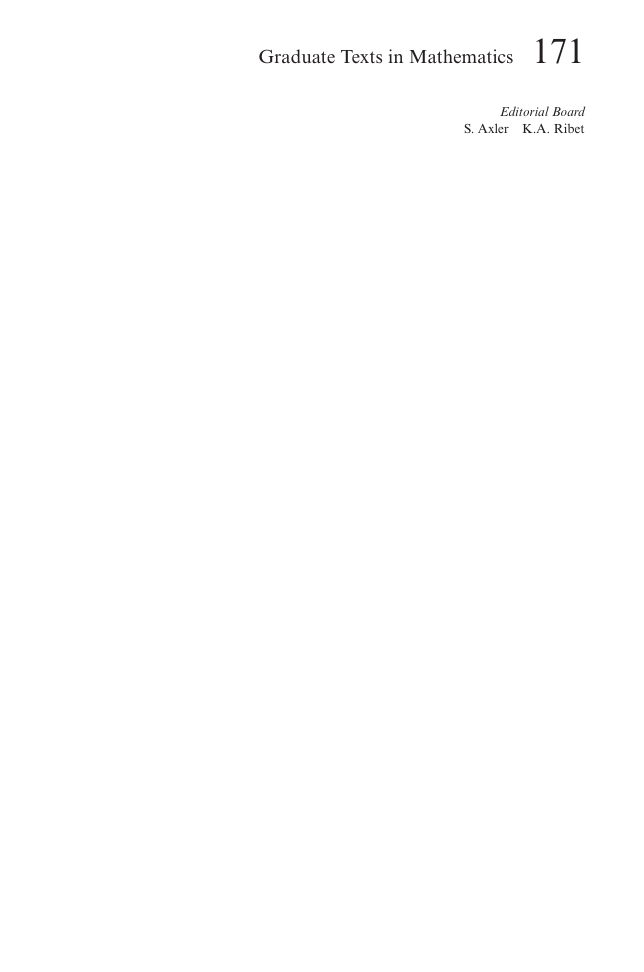

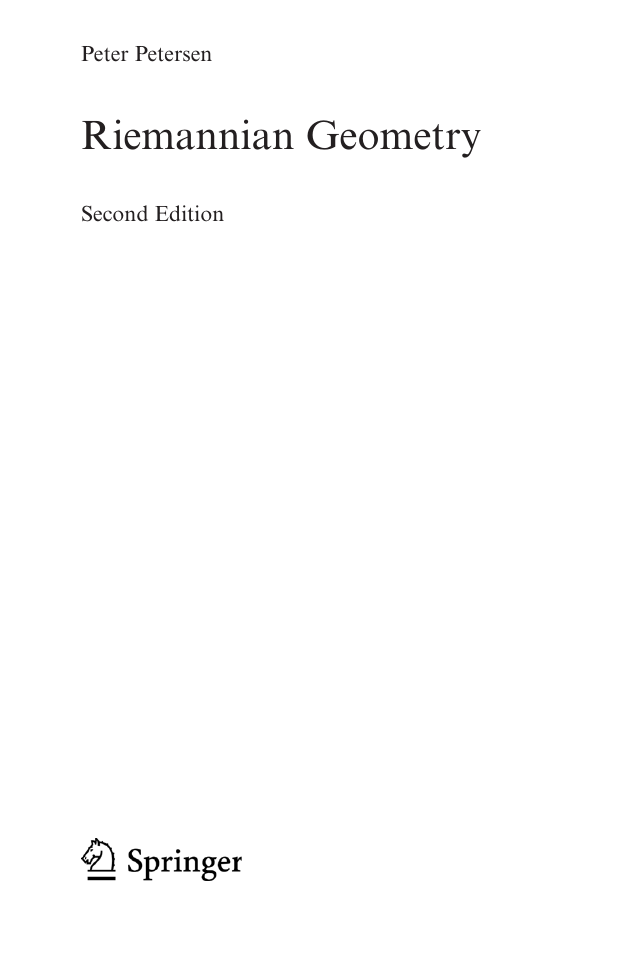
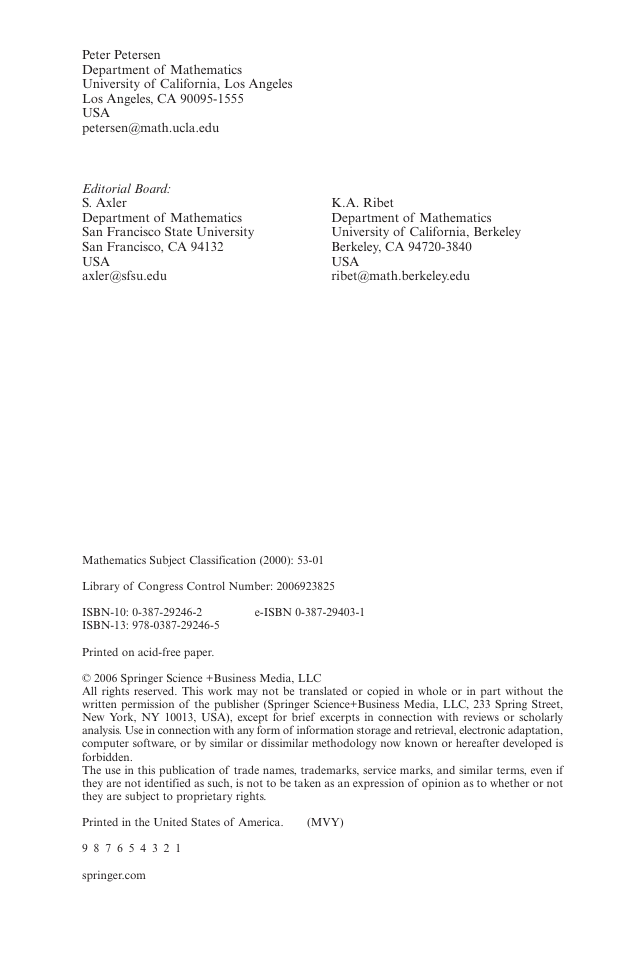

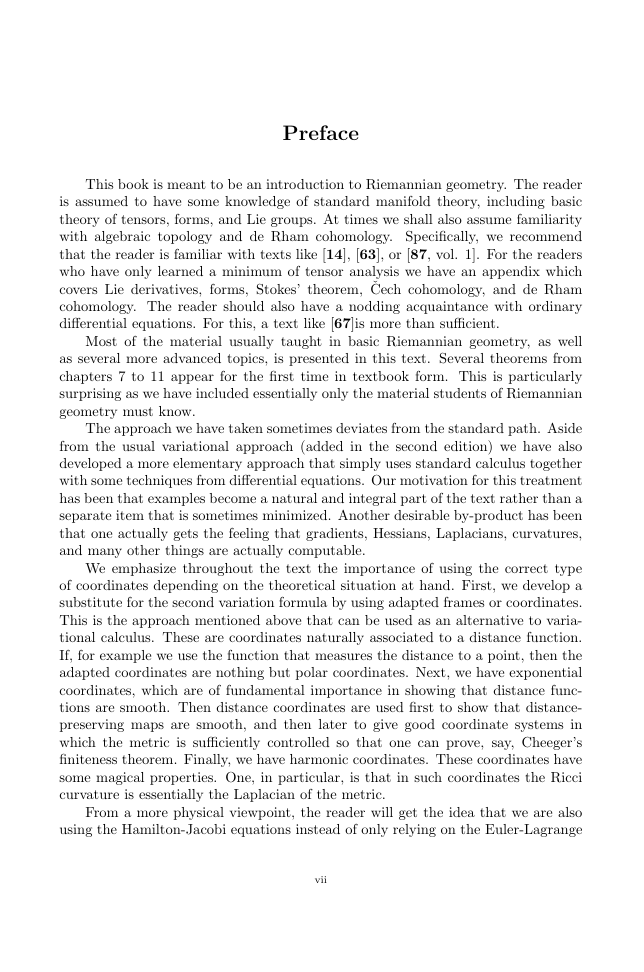

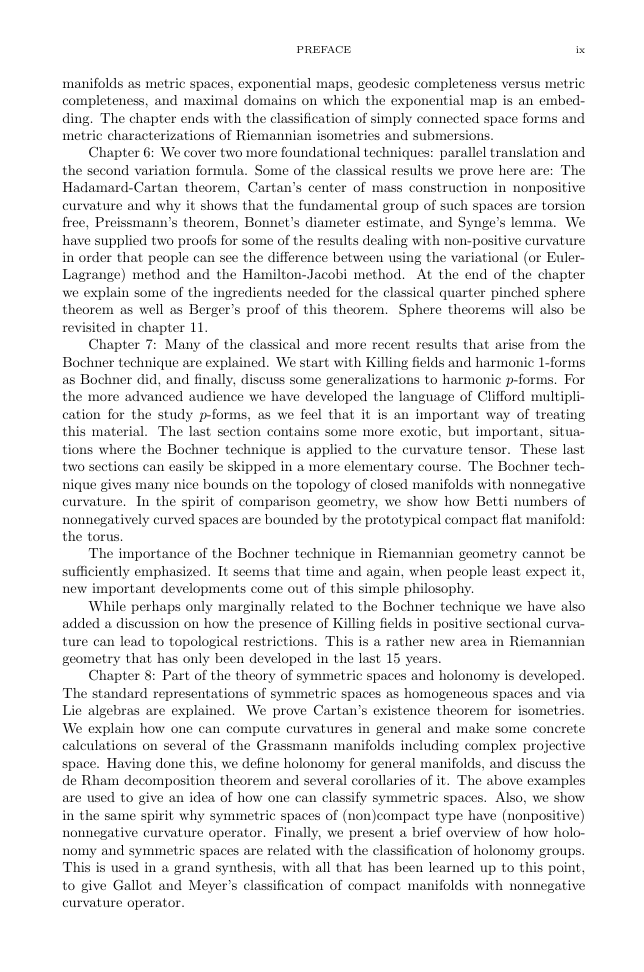








 2023年江西萍乡中考道德与法治真题及答案.doc
2023年江西萍乡中考道德与法治真题及答案.doc 2012年重庆南川中考生物真题及答案.doc
2012年重庆南川中考生物真题及答案.doc 2013年江西师范大学地理学综合及文艺理论基础考研真题.doc
2013年江西师范大学地理学综合及文艺理论基础考研真题.doc 2020年四川甘孜小升初语文真题及答案I卷.doc
2020年四川甘孜小升初语文真题及答案I卷.doc 2020年注册岩土工程师专业基础考试真题及答案.doc
2020年注册岩土工程师专业基础考试真题及答案.doc 2023-2024学年福建省厦门市九年级上学期数学月考试题及答案.doc
2023-2024学年福建省厦门市九年级上学期数学月考试题及答案.doc 2021-2022学年辽宁省沈阳市大东区九年级上学期语文期末试题及答案.doc
2021-2022学年辽宁省沈阳市大东区九年级上学期语文期末试题及答案.doc 2022-2023学年北京东城区初三第一学期物理期末试卷及答案.doc
2022-2023学年北京东城区初三第一学期物理期末试卷及答案.doc 2018上半年江西教师资格初中地理学科知识与教学能力真题及答案.doc
2018上半年江西教师资格初中地理学科知识与教学能力真题及答案.doc 2012年河北国家公务员申论考试真题及答案-省级.doc
2012年河北国家公务员申论考试真题及答案-省级.doc 2020-2021学年江苏省扬州市江都区邵樊片九年级上学期数学第一次质量检测试题及答案.doc
2020-2021学年江苏省扬州市江都区邵樊片九年级上学期数学第一次质量检测试题及答案.doc 2022下半年黑龙江教师资格证中学综合素质真题及答案.doc
2022下半年黑龙江教师资格证中学综合素质真题及答案.doc